
Longfellow home preserves poet’s life
CAMBRIDGE, Mass.— A dark wooden armchair sits next to the fireplace.
It’s almost 130 years old, but its source will live on forever, immortalized in Henry Wadsworth Longfellow’s poem “The Village Blacksmith.” The poem begins,
Under a spreading chestnut-tree
The village smithy stands;
The smith, a mighty man is he,
With large and sinewy hands;
And the muscles of his brawny arms
Are strong as iron bands.
The tree once stood on Brattle Street, not far from the Longfellow Historic Site, part of the National Park Service registry since 1972. Longfellow wasn’t happy when, in 1876, the tree was chopped down in order to widen the street.
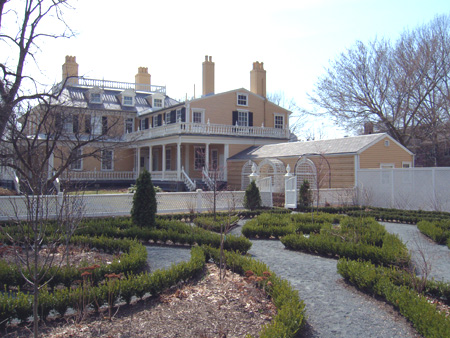 |
The Longfellow home in Cambridge as viewed from the garden (Photo by Tom Minervino). |
Knowing how much the tree meant to Longfellow, the children of Cambridge had wood from the tree made into an armchair, which they presented to him in 1879 for his 72nd birthday.
Taken aback by the gesture, Longfellow penned “From my Arm-Chair” in gratitude. It ends,
Only your love and your remembrance could
Give life to this dead wood,
And make these branches, leafless now so long,
Blossom again in song.
Today, the chair remains in the study of the house the poet lived in from 1837 until his death. The room is decorated with statuettes of Goethe and Dante, a bust of Shakespeare, and portraits of Longfellow’s contemporaries, like Nathaniel Hawthorne and Ralph Waldo Emerson, who frequented the room for Wednesday night gatherings.
To the gatherings, Longfellow would also invite his students and colleagues from Harvard University (he was a professor of modern languages until retiring in 1854 to write full-time) for oysters, fine wine and cigars. He’d read parts of his English translation of Dante’s Divine Comedy, seeking their comments and suggestions.
In the house, there are “the layers of history and stories, spanning three centuries. It’s not just about one person,” said museum manager James Shea.
The house’s walls are lined with over 14,000 books in more than 20 languages, the majority having belonged to Longfellow. Volumes by Voltaire, Cervantes, Sappho, and many others fill the shelves.
“He was a trailblazer in bringing the study of foreign languages and cultures to America,” said Jeanne Dumas, a park ranger and Longfellow Historic Site tour guide.
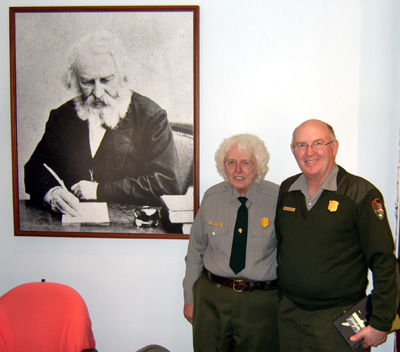 |
Park rangers Jeanne Dumas and Paul Blandford pose in front of a photograph of Henry Wadsworth Longfellow (Photo by Tom Minervino). |
In the entry hall, there is a bust of George Washington, who resided in the house prior to Longfellow. While commanding the Continental Army, Washington made the house the military headquarters for the nine-month Siege of Boston. The house had been abandoned on the eve of the American Revolution by its original owner, loyalist John Vassall.
Much of the home’s exterior improvements can be credited to Andrew Craigie, America’s first Apothecary General, who purchased it in 1791. He added the porches and balconies that surround the structure. “He gave great parties,” said Dumas. The house came to be known as “Castle Craigie” as a tribute to its grandeur and popularity with foreign dignitaries.
Following Craigie’s death in 1819, his widow, Elizabeth, decided to take in boarders. When Longfellow inquired about renting a room in 1837, Mrs. Craigie thought he looked too youthful—she wanted an older, established gentleman. Longfellow pointed out that he had written the book she was currently reading and she changed her mind, offering him a room.
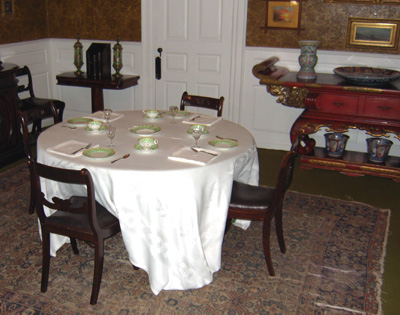 |
The dining room of the Longfellow home displays a place setting typical of the author’s era (Photo by Tom Minervino). |
For the next several years, Longfellow would make the short walk to Harvard University to teach his classes.
“It’s a home for people of special privilege,” Dumas said. “Longfellow’s special service was that he protected the legend and history of the nation with his words.”
Even as a respected professor and poet, Longfellow never could have afforded to buy Castle Craigie on his own. In 1843, he married Fanny Appleton. Her father bought the couple the house as a wedding gift. The couple would have six children there before Fanny’s tragic death.
On a summer day in 1861, Fanny was sealing an envelope with hot wax. Her dress caught on fire, and she was badly burned. Longfellow tried to save her, receiving burns on his face that he would conceal with a beard for the rest of his life, but she died in their upstairs bedroom a few days later.
| Longfellow’s bedroom is preserved with original furniture (Photo by Tom Minervino). |
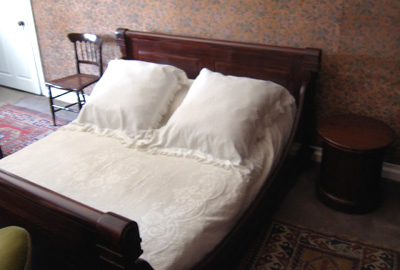 |
Years later, the room still reminded Longfellow of his wife. In 1879, he wrote the sonnet “The Cross of Snow” memorializing his wife. An excerpt reads,
Here in this room she died, and soul more white
Never through martyrdom of fire was led
To its repose; nor can in books be read
The legend of a life more benedight.
Three years after writing the sonnet, Longfellow died in the same bedroom. Though he continued to write until his death, many think he never fully recovered from Fanny’s passing. Dumas said his poems became deeper and more emotional after his wife died.
“He believed a poet should not write from mind and intellect, but from his heart,” she said.
| The Longfellow home from the street in Cambridge (Photo by Tom Minervino). |
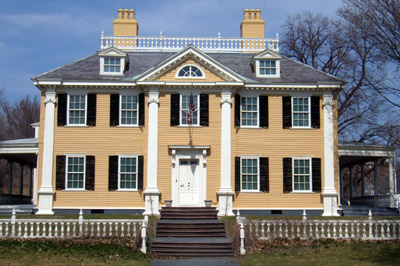 |
If You Go:
Longfellow Historic Site
Basics:
- The house is open seasonally, with guided tours offered from 10 a.m. to 4:30 p.m., Tuesdays to Sundays. It is recommended that visitors call 617-876-4491 to check current days and hours of operation, as they may vary based on annual funding.
- The grounds are open from dusk to dawn year-round.
- Guided tours are $3 for those 16 and older, and free for those under 16. Tours last about an hour.
Getting to the site:
- The house is located at 105 Brattle St., Cambridge, Mass.
- Only handicapped parking is available on-site. Metered parking may be available nearby and there are parking garages in Harvard Square, a 10-minute walk.
- On the MBTA Subway, take the Red Line to Harvard Square; exit the station on Church Street. Follow Church Street to Brattle Street, where you turn right. The house is on the right.
- For more information, visit http://www.nps.gov/long. The Web site provides a wealth of information, including a virtual tour and downloadable “State of the Park” report (PDF).

Comments are Closed